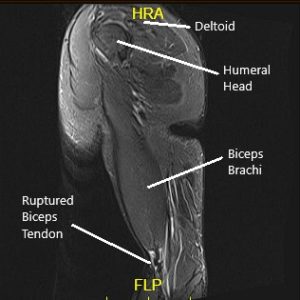Case Study: Management of Distal Bicep Rupture
in a 38-year-old Female with Tenodesis Button and Screw
The patient is a 38-year-old female who sustained an injury to her left elbow while she was trying to prevent a fall while at work. The patient works as an assistant at a nursing home. She heard a pop and pain in her elbow and arm.
She got an X-ray and MRI which showed a complete rupture of the distal biceps. She reported to our office with complaints of pain and loss of function. The patient states she feels a spasm in his left arm. The patient states she can not make a fist or turn the arm.
The pain is extremely severe in intensity. The pain is constant and does disturb sleep. The pain is associated with numbness. The pain is not associated with swelling, bruising, tingling, radiating pain, weakness, bowel or bladder abnormality, gait problem, giving way, or limping, hand function difficulty. The problem has been getting unchanged since it started.
The patient’s medical history is significant for diabetes mellitus and hypothyroidism. Both her conditions are under control with medications. She is currently on Metformin and Levothyroxine. She is taking muscle relaxants and NSAIDs for pain. She denied any previous surgical history. She had no known drug allergies.
On examination, tenderness was present over the long head of the biceps tendon and over the distal biceps tendon. Mild swelling was present on examination. The range of motion was restricted secondary to pain. Motor and sensory examination of the upper extremity was normal and intact. Distal pulses were palpable and good volume. The examination of the contralateral upper extremity was unremarkable.
MRI suggested a complete tear of the distal biceps tendon with tendon retraction to the level of the radial capitellum joint line with fluid along the course. There was no muscle atrophy and no denervation edema.

MRI showing the bicep tendon rupture.
Various treatment options including surgical and nonsurgical were discussed with the patient. The risks, benefits, and complications of all treatment options were discussed at length with the patient. The patient opted for surgical management and signed informed consent.
PREOPERATIVE DIAGNOSIS: Distal biceps rupture Left.
POSTOPERATIVE DIAGNOSIS: Distal biceps rupture Left.
OPERATION: Open repair of the distal biceps using the tenodesis button and tenodesis screw.
DESCRIPTION OF PROCEDURE: The patient was taken to the operating room where he was placed on a well-padded operating table. A hand table was put on the left side. General anesthesia was induced. The left arm was put in a high arm tourniquet followed by usual aseptic prep and draping. A time-out was called. Tourniquet was elevated after exsanguination.
An incision was given about 3 cm distal to the elbow crease line. A transverse incision of about 5 cm in length. With sharp and blunt dissection, the medial border of the brachioradialis was reached. The lateral antebrachial cutaneous nerve was seen and dissected free and retracted gently on the lateral side.
Biceps aponeurosis could be seen and tacked on to the biceps stump, which was folded up to itself and stuck to the surrounding tissue. The stump was released with sharp and blunt dissection and delivered out of the wound. The stump was prepared using #2 FiberLoop with whipstitch sutures.
Now, the radial tuberosity was exposed using a periosteal elevator and retracted. A 3.2 drill bit was passed bicortical and checked under C-arm and found to be over radial tuberosity. 8mm reamer was used to ream the single cortex of the radius at the level of the neck. The biceps tendon stump was 7 mm in diameter.
Now, the button was loaded and put on the inserter and passed through both cortices of the radius. The button was flipped and was felt to be against the cortex. The tendon was tightened on to the button. C arm pictures were taken to confirm that the button was subcortical over the bone. The tendon was tightened into the tunnel.
A curved needle was taken and one limb of the suture was passed through the tendon and a knot was tied. Now, the other limb was passed through the screwdriver using a wire passer. The screw was brought on to the radial side of the unicortical hole and finally tightened flush with the bone.
The tendon repair was found to be satisfactory. The C-arm images were saved. The wound was thoroughly washed. Tourniquet was removed and hemostasis was achieved.
Closure of the wound was done using Vicryl #2-0 and Monocryl #4-0. The forearm was maintained in supination and 30-degree flexion during the whole procedure. Steri-Strips were applied. Dressing using 4 x 4s, ABD, Webril, and Ace wrap was done. The left upper extremity was put in a shoulder sling. The patient was extubated and moved to the recovery unit in a stable condition.
Disclaimer – Patient’s name, age, sex, dates, events have been changed or modified to protect patient privacy.

Dr. Suhirad Khokhar
My name is Dr. Suhirad Khokhar, and am an orthopaedic surgeon. I completed my MBBS (Bachelor of Medicine & Bachelor of Surgery) at Govt. Medical College, Patiala, India.
I specialize in musculoskeletal disorders and their management, and have personally approved of and written this content.
My profile page has all of my educational information, work experience, and all the pages on this site that I've contributed to.
